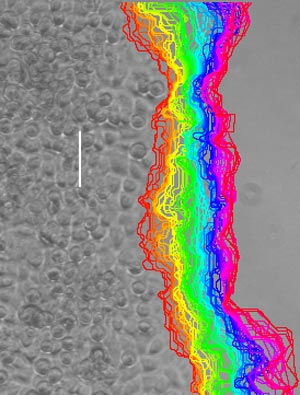Cells migrate collectively by intermittent bursts of activity

This is how cells are migrating. He-La cells - the oldest and most commonly used human cell line - on collagen substrate: time evolution of the front superimposed on the first frame of experiment. Credit: Oleksandr Chepizhko / Aalto University
When you have got a wound and it starts healing, cells start to migrate in your body to the wound. They are driven by active internal forces to invade the available space. Cell migration doesn't only take place when you are getting better. In cancer invasion cells also migrate collectively.
Tissue formation during embryonic development requires the orchestrated movement of cells to specific locations. In general, cell migration is a central process in the development and maintenance of multicellular organisms.
Researchers of Aalto University and their research partners have now discovered that this motion occurs by intermittent bursts of activity. It can be described by universal scaling laws similar to the ones observed in other driven systems outside of biology.
– Our results demonstrate that living systems display universal non-equilibrium critical fluctuations, induced by cell mutual interactions, that are usually associated to externally driven inanimate media, says Oleksandr Chepizhko, Postdoctoral Researcher at Aalto University.
Researchers substantiated the analogy between collective cell migration and depinning by revealing and characterizing widely distributed bursts of activity in the collective migration of different types cells over different substrates and experimental conditions.
After that, they compared the experiments with simulations of a computational model of active particles. They found that in all these cases the statistical properties of the bursts follow universal scaling laws that are quantitatively similar to those observed in driven disordered systems.
Errors during cell migration may have serious consequences. For instance, errors may cause vascular disease, intellectual disability, metastasis or tumor formation. Increased understanding of the mechanism by which cells migrate may lead to the development of new therapeutic strategies for controlling, for example, invasive tumour cells.
Full bibliographic information
Oleksandr Chepizhko et al.: Bursts of activity in collective cell migration. PNAS 2016. DOI 10.1073/pnas.0709640104
Notes for editors
For more information:
Mikko Alava
Professor, Department of Applied Physics, School of Science, Aalto University
mikko.alava@aalto.fi
https://people.aalto.fi/new/mikko.alava
Tweet: Cells migrate collectively by intermittent bursts of activity @aaltouniversity DOI 10.1073/pnas.0709640104
Media Contact
All latest news from the category: Life Sciences and Chemistry
Articles and reports from the Life Sciences and chemistry area deal with applied and basic research into modern biology, chemistry and human medicine.
Valuable information can be found on a range of life sciences fields including bacteriology, biochemistry, bionics, bioinformatics, biophysics, biotechnology, genetics, geobotany, human biology, marine biology, microbiology, molecular biology, cellular biology, zoology, bioinorganic chemistry, microchemistry and environmental chemistry.
Newest articles

Why getting in touch with our ‘gerbil brain’ could help machines listen better
Macquarie University researchers have debunked a 75-year-old theory about how humans determine where sounds are coming from, and it could unlock the secret to creating a next generation of more…

Attosecond core-level spectroscopy reveals real-time molecular dynamics
Chemical reactions are complex mechanisms. Many different dynamical processes are involved, affecting both the electrons and the nucleus of the present atoms. Very often the strongly coupled electron and nuclear…

Free-forming organelles help plants adapt to climate change
Scientists uncover how plants “see” shades of light, temperature. Plants’ ability to sense light and temperature, and their ability to adapt to climate change, hinges on free-forming structures in their…





















